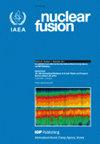Effect of parallel flow on resonant layer responses in high beta plasmas
IF 4
1区 物理与天体物理
Q1 PHYSICS, FLUIDS & PLASMAS
引用次数: 0
Abstract
Resonant layers in a tokamak respond to non-axisymmetric magnetic perturbations by amplifying the mode amplitude and balancing the plasma rotation through magnetic reconnection and force balance, respectively. This resonant response can be characterized by local layer parameters and especially by a single quantity in the linear regime, the so-called inner-layer Δ. The computation of Δ under two-fluid drift-MHD formalism has been progressed by reducing the order of the system in the phase space, where the shielding current is approximated as being only carried by electrons, a posteriori. In this study, we relax the approximation and compute Δ accounted for by the parallel flow associated with the ion shielding current. The posteriori is numerically verified in great agreement with the original SLAYER developed in a previous paper (J.-K. Park 2022 Phys. Plasmas29 072506). Extending the resonant layer response theory to high β plasmas, our research findings answer two important questions: how the parallel flow influences the resonant layer response and why the parallel flow effect appears in high β plasmas. The complicated plasma compression in high β regime allows the parallel flow response to give rise to the ion shielding current, which not only shifts the zero-crossing condition of the ExB flow but also enhances the field penetration threshold. Technically, the Riccati matrix transformation method is adapted to handle the numerical stiffness due to the increased order of the system. The high fidelity of this numerical method makes use of further extension of the model to higher-order systems to take other physical phenomena into account. This work is envisaged to predict the resonant layer response under high β fusion reactor conditions.平行流对高β等离子体中谐振层响应的影响
托卡马克中的谐振层对非轴对称磁扰动的响应是通过磁重联和磁力平衡分别放大模式振幅和平衡等离子体旋转。这种共振响应可以用局部层参数来表征,特别是线性机制下的一个单一量,即所谓的内层Δ。在双流体漂移-MHD 形式下,Δ 的计算已经取得了进展,方法是降低相空间中系统的阶数,在相空间中屏蔽电流被近似为仅由电子携带。在本研究中,我们放宽了近似值,并计算了与离子屏蔽电流相关的平行流所占的Δ。通过数值验证,后验法与之前论文(J.-K. Park 2022 Phys. Plasmas29 072506)中开发的原始 SLAYER 非常一致。将共振层响应理论扩展到高β等离子体,我们的研究成果回答了两个重要问题:平行流如何影响共振层响应,以及平行流效应为何出现在高β等离子体中。高 β 体系中复杂的等离子体压缩使得平行流响应产生了离子屏蔽电流,这不仅改变了 ExB 流的零交叉条件,还提高了场穿透阈值。在技术上,里卡提矩阵变换方法适用于处理因系统阶数增加而产生的数值刚度。这种数值方法的高保真性使得模型可以进一步扩展到高阶系统,以考虑其他物理现象。这项工作旨在预测高 β 核聚变反应堆条件下的共振层响应。
本文章由计算机程序翻译,如有差异,请以英文原文为准。
求助全文
约1分钟内获得全文
求助全文
来源期刊

Nuclear Fusion
物理-物理:核物理
CiteScore
6.30
自引率
39.40%
发文量
411
审稿时长
2.6 months
期刊介绍:
Nuclear Fusion publishes articles making significant advances to the field of controlled thermonuclear fusion. The journal scope includes:
-the production, heating and confinement of high temperature plasmas;
-the physical properties of such plasmas;
-the experimental or theoretical methods of exploring or explaining them;
-fusion reactor physics;
-reactor concepts; and
-fusion technologies.
The journal has a dedicated Associate Editor for inertial confinement fusion.
 求助内容:
求助内容: 应助结果提醒方式:
应助结果提醒方式:


